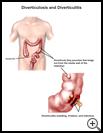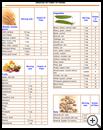
Diverticulitis
________________________________________________________________________
KEY POINTS
- Diverticula are tiny pouches or weak areas that bulge out from the inside wall of the intestine, usually in the colon. Diverticulitis usually happens when stool or bacteria is caught in the pouches and causes swelling, irritation, and infection.
- Mild diverticulitis is usually treated with antibiotic medicine and changes in diet. With more severe diverticulitis, you may need antibiotic medicine, IV fluids, or surgery.
- Follow the full course of treatment prescribed by your healthcare provider. Take antibiotics for as long as your healthcare provider prescribes, even if you feel better.
________________________________________________________________________
What is diverticulitis?
Diverticula are tiny pouches or weak areas that bulge out from the inside wall of the intestine. The pouches are usually in the part of the intestine called the colon. They look like small thumbs poking out of the side of the intestine. When you have these pouches in your intestines, it is called diverticulosis. There may be swelling and irritation of the pouches with diverticulitis.
You are more likely to have these pouches as you get older.
What is the cause?
The exact cause of diverticulitis is not known. It is possible that too little fiber in the diet may cause hard stools or constipation. Your muscles strain to move stool that is too hard. The high pressure causes the weak spots in your colon to bulge out and form pouches. If stool or bacteria get caught in these pouches, it can cause swelling, irritation, and infection.
What are the symptoms?
Symptoms may include:
- Having diarrhea some of the time and constipation some of the time
- Pain or cramping in your belly that may come and go. The pain is often felt on the left lower side of the belly.
- Fever
- Nausea and vomiting
- Rectal bleeding
How is it diagnosed?
Your healthcare provider will ask about your symptoms and medical history and examine you. Tests may include:
- Colonoscopy, which uses a flexible, lighted tube put into your rectum to look at the inside of your colon. A similar test called a sigmoidoscopy looks at just the lower one-third of your colon.
- Barium enema, which is an X-ray taken of the belly after barium is inserted into the rectum to show the walls of the intestine and any possible problems. Barium is a liquid that helps your intestines show up well on the X-ray.
- Blood tests
How is it treated?
Diverticulitis is usually mild and is treated with antibiotics and changes in diet.
If you are having an attack of acute diverticulitis, you may need to stay in the hospital. Your treatment may include antibiotics and IV fluids. You may also have a tube put through your nose to remove the contents of your stomach, which relieves pressure in your intestines.
If attacks are severe or frequent, you may need surgery. Two types of surgery can be done to correct the problem:
- The area of the colon with the infected diverticula may be removed and the remaining ends of the colon sewn back together.
- You may have a colostomy to bypass the inflamed colon to help it heal. A colostomy attaches part of the healthy colon to an opening in your belly. Bowel movements will then leave your body through this new opening. It will be collected in a disposable bag. After the colon has healed, the colostomy can be reversed. This means that you will have a second surgery to rejoin the ends of intestine to each other, and no longer have an opening in the wall of your belly.
How can I take care of myself?
Follow the full course of treatment prescribed by your healthcare provider. Take antibiotics for as long as your healthcare provider prescribes, even if you feel better. If you stop taking antibiotics too soon, the infection and your symptoms may come back. In addition:
- If you have diarrhea, drink clear liquids and avoid solid foods for a few hours. Try to rest until the diarrhea stops. When your symptoms are gone, eat soft, bland, low-fiber foods, such as boiled vegetables, noodles, or bananas. Your healthcare provider will let you know when you should gradually start eating a high-fiber diet.
- Ask your provider:
- How and when you will get your test results
- How long it will take to recover
- If there are activities you should avoid and when you can return to your normal activities
- How to take care of yourself at home
- What symptoms or problems you should watch for and what to do if you have them
- Make sure you know when you should come back for a checkup. Keep all appointments for provider visits or tests.
How can I help prevent diverticulitis from coming back?
- Once you are well, eat a healthy diet that includes high-fiber foods, such as fruits, vegetables, and whole-grain foods. Ask your healthcare provider if you should take fiber supplements.
- Keep a food diary to track what foods seem to cause pain. Foods such as popcorn kernels, sunflower seeds, sesame seeds, and nuts may get stuck in diverticula and cause swelling and irritation. The seeds in tomatoes, zucchini, cucumbers, strawberries, and raspberries, as well as poppy seeds, are usually not a problem.
- Drink plenty of water.
- Watch for changes in your normal bowel pattern. If you are having problems with constipation or diarrhea, contact your healthcare provider.
- Take care of your health. Try to get at least 7 to 9 hours of sleep each night. If you smoke, try to quit. If you want to drink alcohol, ask your healthcare provider how much is safe for you to drink. Learn ways to manage stress. Exercise according to your healthcare provider's instructions.


